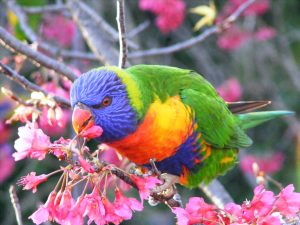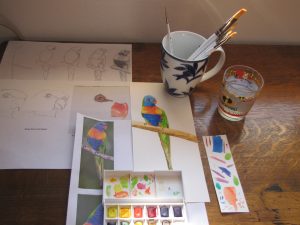You know the old adage, “You can’t teach an old dog new tricks?” Well, thank heavens, I’m not a dog. Though this tired cliché is often used to describe what we can NOT do, I’m here to tell you that there are specific pathways we can walk in order to love learning, whether little tykes or old fogies.
So, to illustrate this point, let me share a little story.
Some months ago, my dear friend, Bernadette, contacted me from Australia to ask if I might enjoy taking art lessons with her via Skype. She knew that I was in a season of resting, and thought it might be therapeutic. Isn’t that amazing? Don’t you love friends??
There was a bit of a problem with this scenario, however. For the past 57 years, I’ve been an absolute klutz when it comes to drawing, painting, or anything requiring more than your basic stick figures. It was more than a little daunting to think of having art lessons with a professional artist, but, since she was so positive about the idea, I thought it was at least worth trying.
So, on the first lesson, once we worked through a few technical computer difficulties, Bernie announced to me that we were going to approach my art lessons in a non-traditional manner. Though most beginning art students spend a lot of time learning how to draw, she thought that I would be much more motivated if I could do things with color. So, to my astonishment, she said that we would start watercolor painting in the next lesson.
Gulp. I assumed that Bernie had missed the memo that said I am not an artist, not a painter, not talented artistically. But, on the other hand, she was absolutely right about how excited I suddenly became when I found that I would get to play with color!
Our next few lessons focused on painting apples and feathers, in addition to looking at some beautiful art masterpieces, and talking about line, tone and color. But, in the midst of explaining a bit about color, she happened to show me something she was doing with another class. It was a half-finished painting of a rainbow lorikeet.
If you haven’t been to Australia, you might not be familiar with this absolutely gloriously-colored bird. It is so common in Australia that I think most folks there don’t even recognize what a show-stopper this bird is!
Here’s a photo of a rainbow lorikeet, so you can see for yourself.
When I saw Bernie’s painting, I squealed, “Oh, can I do a rainbow lorikeet, too????” Though I am sure it was not originally the next step in her lesson plan for me, she recognized that my enthusiasm would motivate me and carry me much further into watercolor. And, bravely, she said, “Why, YES!”
As we were working together on painting this lorikeet a few nights ago, Bernie told me something revolutionary—at least, it seemed radically new to me. Painting the feathers of the bird, Bernie said:
“Diana, you know, if you’re in a hurry, you can just drop a bunch of pigment onto the paper. It’s not as nice, but you can do it. However, if you want to get a beautiful effect, just take your time. Take a little bit of pigment and paint a bit, then let it dry. After awhile, come back to that same spot and add a little bit more pigment. In this way, as you create the painting, little by little, layer upon layer, it will result in a luminescence and a reality that is not possible when you’re in a hurry.”
As I was considering today’s blog, I realized that Bernie’s brilliant approach to teaching illustrates some of the most powerful pathways for learning, regardless of the subject or the age of the student. So, let’s consider what they are:
First, Bernie knows me. She knows my passion for color, though we are on opposite sides of the world and quite different in our expression of color. (She creates exquisite pieces of art that are nearly white on white, while I delight in strong colors.) She also knows that I was feeling hopelessly inept as an art student.
Second, because of this knowledge, she modified the traditional art curriculum in order to ignite my enthusiasm and engage me in painting. Working with my strength (a love of color) helped me to get past the obstacle of thinking I could not learn this subject.
Third, Bernie was flexible in her lesson plan. When she saw my excitement over painting a lorikeet, she was willing to change her plans because she knew that it was an opportunity to captivate me with the subject.
Fourth, Bernie taught me to do things little by little. Rather than requiring me to create a painting in one session, she encouraged me to work on it a bit, come back and do some more, and to take as much time as I needed.
What is the take-away from this little story?
More than any teacher on the planet, you know your kids. You have insight into what they are passionate about, and what makes them feel inept.
More than any other teacher on the planet, you have the freedom to modify the curriculum in order to work with the specific interests of your students. Do they love dance? Then incorporate dance into their studies. For instance, let them interpret what they’ve learned in history through a bit of choreography.
More than any other teacher on the planet, you can be flexible with your lesson plan and schedule. If you see a sudden interest arising in your student, then make it a priority, change your schedule, and allow it in your lesson plan. (Before you run away screaming, “Not another thing in my lesson plan!!!!,” let me assure you that I am going to take each one of these points over the next few blogs and flesh them out for you, so you can see that you will not be overwhelmed or have more added to your plate. If anything, you will probably find new space in your schedule as you toss some things that haven’t been working!)
Finally, more than any other teacher on the planet, you can give your students the glorious liberty of doing things little by little. Rather than huge blobs of multiplication tables or phonics or chemistry (which can be daunting for anyone), you can allow them to take things slowly and in increments. This removes the huge burden of having to do things perfectly, of having to learn things instantly, or of trying to master something when you’re a newbie and overwhelmed.
Believe me, once a student gets excited, then little by little, anything is possible!
Here’s my first painting of a rainbow lorikeet, thanks to Bernie’s brilliant instruction. . .


